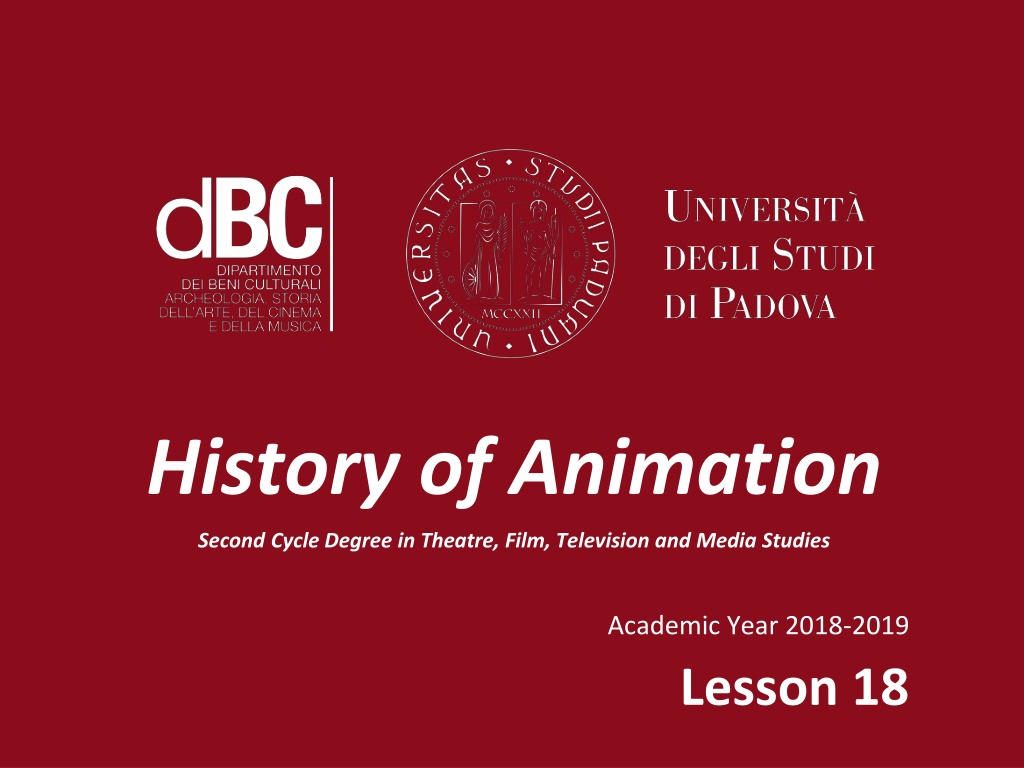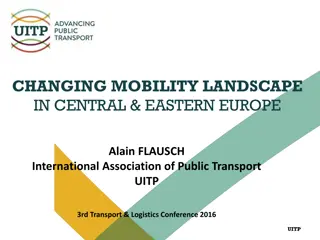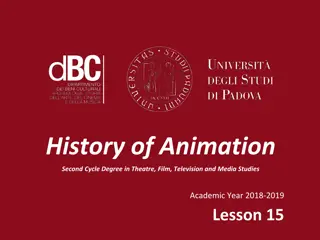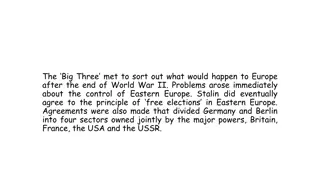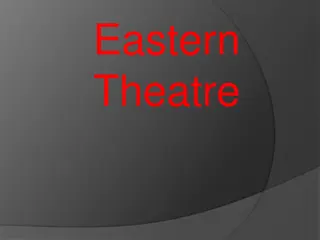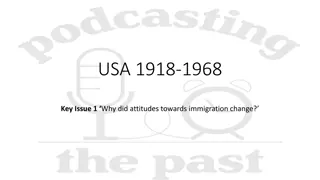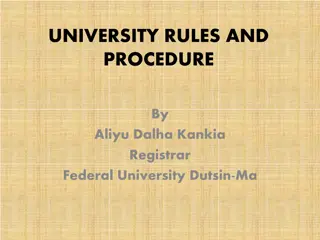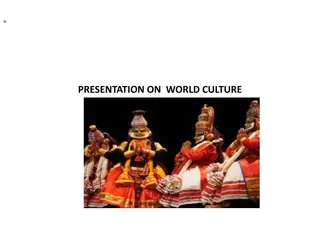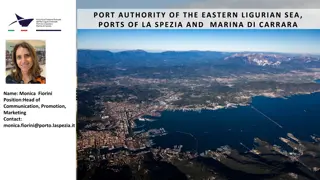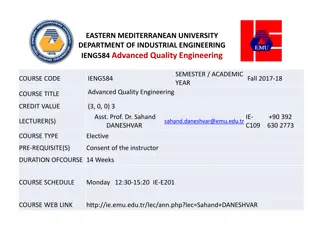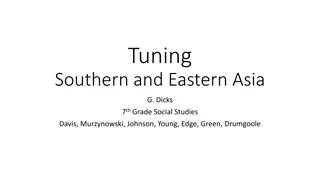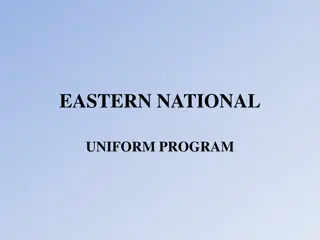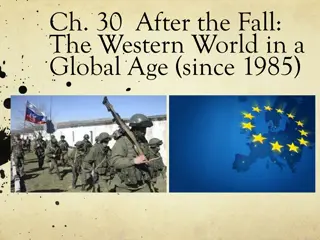Evolution of Animation in Eastern Europe: A Historical Overview
Before 1989, Eastern European animators faced challenges under Stalinism, leading to a focus on folk tales and legends. Czechoslovakia played a significant role with studios like AFIT and key figures like Karel Zeman and Jiří Trnka influencing the development of puppet animation and unique visual styles blending live action and animation.
Download Presentation

Please find below an Image/Link to download the presentation.
The content on the website is provided AS IS for your information and personal use only. It may not be sold, licensed, or shared on other websites without obtaining consent from the author. Download presentation by click this link. If you encounter any issues during the download, it is possible that the publisher has removed the file from their server.
E N D
Presentation Transcript
History of Animation Second Cycle Degree in Theatre, Film, Television and Media Studies Academic Year 2018-2019 Lesson 18
Animation in Europe 4 Schools and authors of Eastern Europe
Animation in Europe 4 Before 1989, East European countries suffered the influence of Stalinism. The only possible cinema was a state-funded one. Censorship and socialist realism forced animators to avoid references to avant-garde movements. Their inspiration mostly came from harmless sources, such as folk songs, legends and fairy tales. However, as the influence of Stalinism faded away, East European animation tackled also social and political issues.
Animation in Europe 4 Czechoslovakia Czechoslovakia Since the 1930s, the most important Czechoslovakian studios were in Prague. Karel Dodal established in 1935 (The Lantern s secret) a longstanding tradition of puppet animation of this country. In the same year, a studio was founded in Prague: AFIT (Atelier Filmovych Triku). It provided special effects for live-action films; during the World War II it was confiscated and managed by nazis.
Animation in Europe 4 Czechoslovakia After animators were ready to start their careers. In 1945, Jir Trnka renamed the Prague studio Bratri v triku ( The brothers in shirt or The brothers of tricks ). the liberation, many young
Animation in Europe 4 Czechoslovakia Karel Zeman (1910-1989) He started from puppet animation (Inspirace, 1948); his best works, however, feature a unique and pictorial mix-up of live action and animations, as seen in the films Vyn lez zkazy (The Diabolic Invention, 1958) and Baron Pr sil (Baron M nchhausen, 1961).
Animation in Europe 4 Czechoslovakia Inspirace (Karel Zeman, 1948)
Animation in Europe 4 Czechoslovakia The Diabolic Invention (Karel Zeman, 1958)
Animation in Europe 4 Czechoslovakia Ji Trnka (1912-1969) Trnka approached animation at the end of World War II. In his youth, he was a renowned illustrator of books for children, as well as a scene designer for the National Theatre in Prague. His main artistic interest, however, was puppetry: in his early youth, he assisted the foremost Czech puppeteer of the early 20th century, Josef Skupa; Trnka later founded an own puppet theatre in Prague, that was active from 1936 to 1937. Trnka was soon destined to become the most important director of Czech puppet films. At first he dealt with animated drawings (Darek, The Gift, 1946). palicek (The Czech Year, 1947) was his first puppet film.
Animation in Europe 4 Czechoslovakia At first an optimist, fascinated by fairy tales and legends (C saruv Slav k, The Emperor s Nightingale, 1948), Trnka produced his last full length feature in 1959: Sen noci svatoj sk (A Midsummer Night s Dream). In the 60s, however, he fell into a deep depression. This state of mind is clearly evident in Ruka (The Hand, 1965), his last short film: a sour satire on creative freedom.
Animation in Europe 4 Czechoslovakia C saruv Slav k (The Emperor s Nightingale, Ji Trnka, 1948)
Animation in Europe 4 Czechoslovakia Bajaja (Ji Trnka, 1950)
Animation in Europe 4 Czechoslovakia Ruka (The Hand, Jir Trnka, 1965)
Animation in Europe 4 The Zagreb School Yugoslavia: the Zagreb School The activity of the Zagreb School is commonly divided into two periods. The first (1957-1964) was marked by the establishment of limited, abstract hand-drawn animation and a preference of themes revolving around incommunicability and the drama of the human condition. The main directors were Du anVukoti (1923-1998), Vatroslav Mimica (1923) and Vlado Kristl (1923- 2004).
Animation in Europe 4 The Zagreb School Surogat (Du anVukoti , 1961)
Animation in Europe 4 The Zagreb School The second period of the Zagreb School started as, in 1963, all the main directors and animators emigrated or returned to live-action films. So, a new generation of young artists took their place. Individuality was favored over homogeneity; notwithstanding this preference for auteurs, the Zagreb School also produced TV series (as ProfessorBalthazar , by Zlatko Grgi , 1967-1974) and advertisements. During the 1980s, the Zagreb School faded away; however, animation spread to other cities of Yugoslavia, where is still vital.
Animation in Europe 4 The Zagreb School Satiemania (Zdenk Gasparovich, 1978)
Animation in Europe 4 Soviet animation Soviet animation Children s films were the main product of Soviet animation during the fifteen years that followed the end of World War II. The style was a Disney-like one, with cel animation, rounded designs and fairy tale subjects. The opening of a special animation section at Sojuzmultfilm favored a timid renewal (puppet animation and cut-outs started to be used again).
Animation in Europe 4 Soviet animation However, from the 40s to the 60s Soviet animation did not try to express social or political themes. Animators considered themselves good artists at the service of the audience, responsible for good entertainment and methodical teaching. The main authors from this period were Ivan ivanov- Vano, the Brumberg sisters, Lev Atamanov and Mikhail Tsekhanovsky.
Animation in Europe 4 Soviet animation The Snow Queen (Lev Atamanov, 1957)
Animation in Europe 4 Soviet animation Ballerina on a boat (Lev Atamanov, 1969)
Animation in Europe 4 Soviet animation The Little Humpbacked Horse (Ivan Ivanov-Vano, 1947)
Animation in Europe 4 Soviet animation Seasons (Ivan Ivanov-Vano, 1969)
Animation in Europe 4 Soviet animation The 60s brought more diversification among the Soviet animators. Satire and stylistic research became more common, even though there were no revolutionary tendencies. The most relevant Soviet animator of the decade was Fedor Khitruk. His first film, History of a Crime (1961) had an almost neorealist flavour. At the age of 20, in 1961, Yuri Norstein joined Sojuzmultfilm. His first film, The 25th: The First Day (1968) was a commemoration of the October Revolution, and it already showed a distinct directorial style.
Animation in Europe 4 Soviet animation Yuri Norstein would become one of the most respected animators in the world. He developed a complex mixed technique, mainly based on paper cut-outs; his vision of animation favours the enhancement of emotions and sensitivity. His stories are often free recollections of memories and experiences, both cultural and personal. His film The Tale of Tales (1979) has been twice awarded the title of Best Animated Film of All Time (Los Angeles, 1984, and Zagreb, 2002). It is the representation of a free flow of thought about childhood, coming to age and separation, as a metaphor of the relationship between artists and their creations. It is loosely inspired by a poem by Nazim Hikmet.
Animation in Europe 4 Soviet animation History of a Crime (Fedor Khitruk, 1961)
Animation in Europe 4 Soviet animation The Tale of Tales (Yuri Norstein, 1979)
Animation in Asia 1 Animation in Asia: China
Animation in Asia 1 China China For a long time (at least until the 1970s) animation in China was synonym with the Wan Brothers. They were four brothers: Wan Laiming (1900-1997), Wan Guchan (1900-1995), Wan Chaochen (1906-1992) and Wan Dihuan (1907?- unknown). They were set-designer for live-action cinema; they approached animation in an amateurish way, inspired by the productions of the Fleischer Brothers. Their first film was Uproar in the Studio (1926); it is now lost.
Animation in Asia 1 China Wan Dihuan left the Brothers in 1933, to devote himself to photography. The remaining three brothers kept working as animators: they studied foreign animated films and divulged their ideas on art. After the Japanese invasion of Shanghai (1937), and a temporary escape to Wuhan, the Brothers settled in the FrenchConcession in Shanghai. There, they organized a studio and started the production of Princess Iron Fan (1941): the first full-length feature film of Asia. It was inspired by one of the most important works of Chinese literature: Journey to the West, a 16th century novel.
Animation in Asia 1 China Princess Iron Fan (Wan Brothers, 1941)
Animation in Asia 1 China The Shanghai Studio grew bigger at the end of the 40s. The Wan Brothers reunited after a momentary separation (Wan Chaochen traveled to the USA to study American animation; Wan Laiming and Wan Guchan went to Hong Kong during the final years of the World War II). By the 1960s, the Shanghai Studio would count 380 workers. Their production techinques were basically hand-drawn cel animation, puppet and paper cut-out animation. Their most renowned post-war work was the two-part film Confusion in the Sky (1961 and 1964): another take on the Journey to the West. The Studio closed from 1965 to 1972, because of the Cultural Revolution.
Animation in Asia 1 China Zhu Baizhe Eats the Watermelon (Wan Guchan, 1958)
Animation in Asia 1 China Confusion in the Sky (Wan Laiming, 1961 and 1964)
Animation in Asia 1 China During the 70s, and after the fell of the political Gang of Four, the Shanghai Studio was revived. The most important animator of the period was Xu Jingda, also known as A Da. His best work is the short film Three Monks (1980). Chinese animation is today a multi-centered productive reality. Individual artistic research keeps going on; at the same time, however, directors and producers are trying to emulate the best-selling models of Japanese animation.
Animation in Asia 1 China Three Monks (A Da, 1980)
Animation in Asia 1 China Big Fish and Begonia (Liang Xuan, Chun Zhang, 2016)
Animation in Asia 2 Animation in Asia: Japan
Animation in Asia 2 Japan Japan The first historical document of Japanese animation is the Matsumotofragment (1907). It is a fragment of 35 mm clear film, with 50 hand-drawn frames. It shows a boys who writes katsud shashin, that is to say: movingpictures . The Matsumoto fragment was retrieved by dr. Natsuki Matumoto (University of Osaka), in 2005, in a private house in Kyoto. It could prove that Japan developed animation on its own, without influences from the Western Countries.
Animation in Asia 2 Japan The Matsumoto Fragment (1907?)
Animation in Asia 2 Japan 1917: three pioneers. The comic artists tenShim kawa (1892-1973) and Jun ichi K uchi (1886-1970) and the painter Seitar Kitayama. In 1917, they produced 18 short films; their work was called senga eiga ( linefilm ). Kitayama sMomotar (1918) was screened even in France. Kitayama wrote the first Japanese manual of animation; he directed 30 films and founded the first animation studio of Japan, the Kitayama Eiga Seisakush ( Kitayama Film Production Laboratory )
Animation in Asia 2 Japan Namakura Katana: Hanawa Hekonai Meit no Maki (Jun ichi K uchi, 1917; fragment)
Animation in Asia 2 Japan During the 1920s, Yasuji Murata brought to Japan the transparent cel technique. The most relevant animator of this age was Nobur fuji (1900- 1961). He considered animation a form of art, not just something to create advertisements or to entertain children. He founded the Chiyogami Eigasha studio in Tokyo in 1925. His preferred technique was paper-cut outs (kirigami). In particular, he used a special semi-transparent paper, woodcut printed in colour. The name of that paper was chiyogami hence the name of his studio. With the short film Kujira (The Whale, 1927) fuji introduced synchronized sound in Japanese animation. Kuro nyago (The Black Cat) was fuji s first attempt at synchronized dialogue.
Animation in Asia 2 Japan Kokka Kimigayo (Nobur fuji, 1931)
Animation in Asia 2 Japan Kuro nyago (Nobur fuji, 1929)
Animation in Asia 2 Japan The World War II favored the production of many propaganda animated films. Mitsuyo Seo, a former animator at Masaoka Eiga Seisakush (helmed by Kenz Masaoka) was entrusted with Momotar no Umiwashi (Momotar and the Sea Eagles, 1942), the longest animation made in Japan until that point (37 minutes). The success of the film induced the Navy to fund a second Momotar feature: Momotar Umi no Shinpei (Momotar , the Divine Warrior of the Sea, 1945).
Animation in Asia 2 Japan Momotar Umi no Shinpei (Mitsuyo Seo, 1945)
Suggested readings Giannalberto Bendazzi, Animation. A World History. 3 voll., Waltham, Massachusetts: Focal Press, 2015. Vol. II, pp. 57-59 (only the section Czechoslovakia and Puppets ); Vol. II, pp. 60-68 (from and including- the section KarelZeman up to and including- the section The Music of the Puppets ). Vol. II, pp. 68-70 (section Yugoslavia: The First Stage of the Zagreb School ). Vol. II, pp. 262-273 (from and including- the section Yugoslavia: The New Zagreb School , up to and including- the section Otherartists ). Vol. II, pp. 76- 83 (from and including- the section Russia up to and including- the section Ivan Ivanov-Vano ). Vol. II, pp. 280-284 (from and including- the section Russia up to and including- the section Quality Hatches at Soyuzmultfilm ); Vol. II, pp. 294-297 (section Fedor Khitruk ); Vol. II, pp. 301-304 (section YuriNorstein ); Vol. II, pp. 309-311 (section More about it ). Vol. I, pp. 187-188 (section China ); Vol. II, pp. 89-90 (section China ); Vol. III, pp. 270-271 (section China ). Vol. I, pp. 82-84 (chapter SilentAsia ); Vol. II, pp. 85-88: Asia (to study up to and including- the section Experiments ); Vol. II, pp. 335-347: Asia (to study up to and including- the section Toei sFortunes ).
